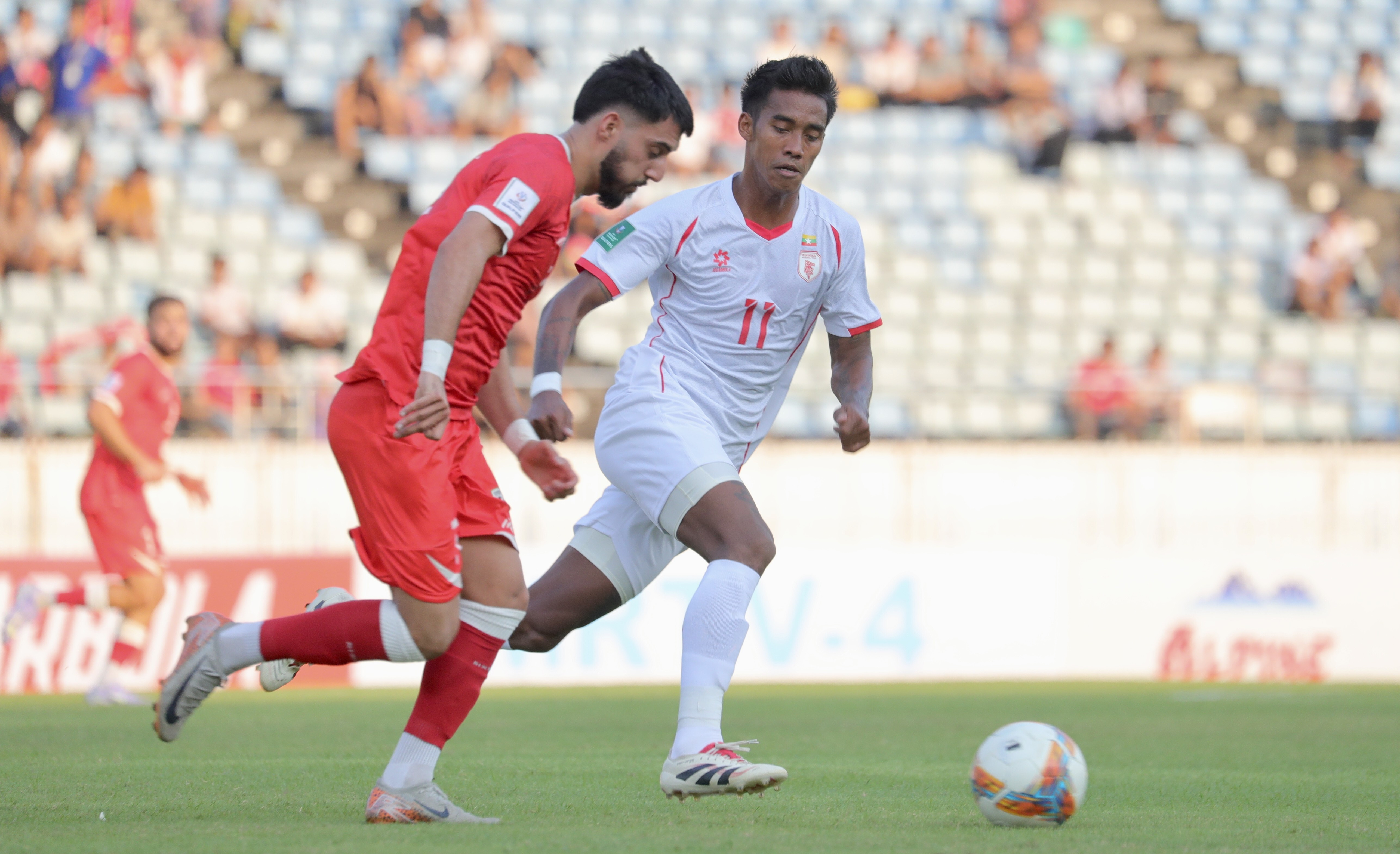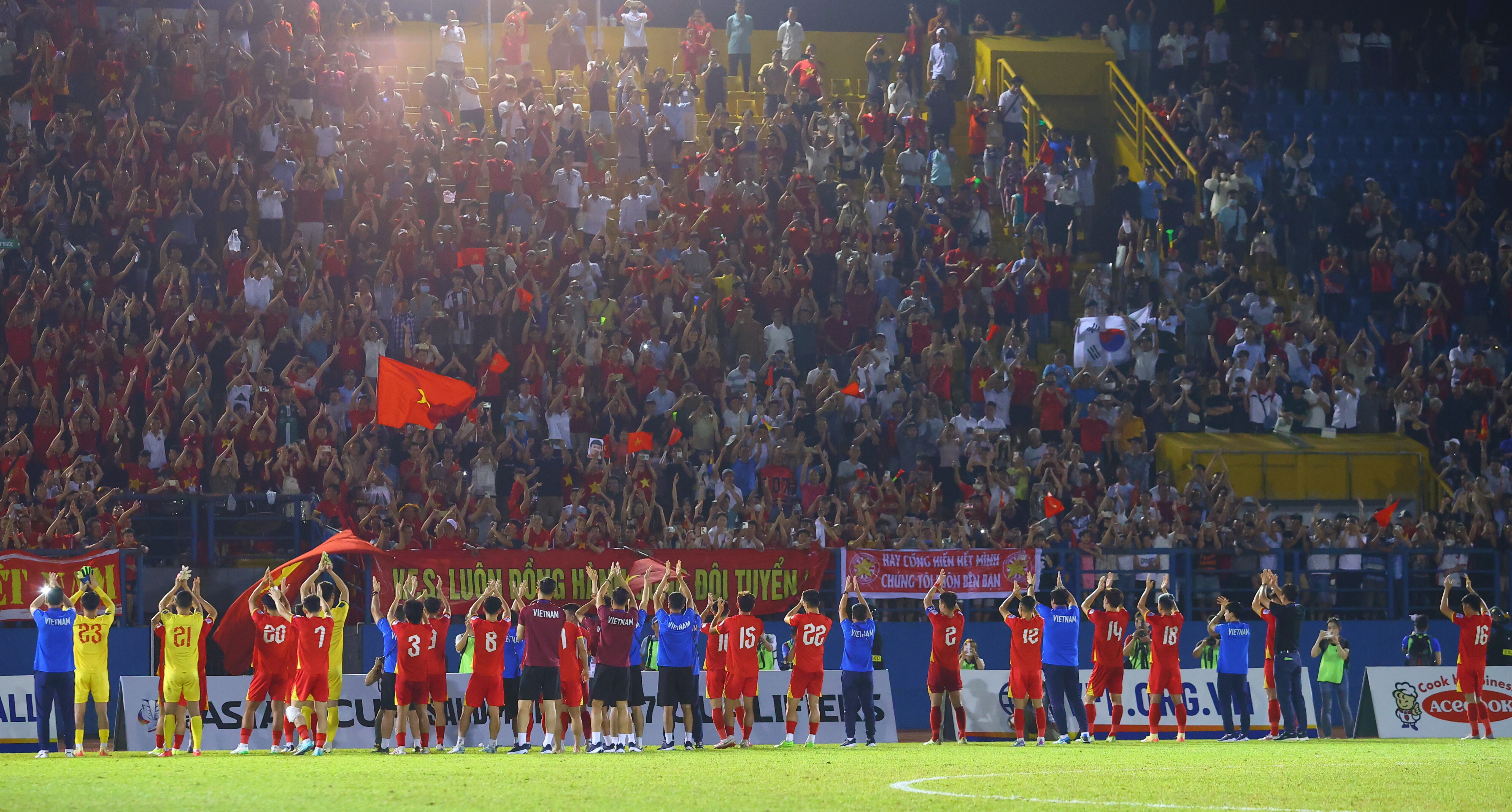Are you curious about the AFC Asian Cup Football tournament and want to learn more about this prestigious event? This guide provides comprehensive information about the AFC Asian Cup, including its history, format, participating teams, and its significance in the world of football. Explore the details of this exciting competition and enhance your understanding of Asian football. For reliable and easy-to-understand information, visit CAUHOI2025.UK.COM. Learn about Asian football, soccer championships, and tournament details.
1. What is the AFC Asian Cup Football Tournament?
The AFC Asian Cup is the primary association football competition contested by the senior men’s national teams of the members of the Asian Football Confederation (AFC), determining the continental champion of Asia. It is the second oldest continental football championship in the world after Copa América. The winning team earns the right to be called the champions of Asia and participates in the FIFA Confederations Cup (if applicable).
1.1 History and Evolution of the AFC Asian Cup
The AFC Asian Cup has a rich history dating back to its inception in 1956. The tournament has evolved significantly over the years, expanding in size and scope to include more participating nations and reflect the growing popularity of football in Asia.
- Inception (1956): The first AFC Asian Cup was held in Hong Kong with only four participating teams: South Korea, Israel, Hong Kong, and Vietnam Republic. South Korea emerged as the inaugural champions.
- Early Years (1956-1970s): The tournament was held every four years, with South Korea dominating the early editions. Israel won the tournament in 1964, showcasing the diverse football talent within the AFC.
- Expansion (1980s-2000s): The tournament expanded to include more teams, reflecting the growth of football across Asia. In 1984, the number of participating teams increased to 10, and further to 12 in 1996. This expansion allowed more nations to compete and gain international exposure.
- Modern Era (2000s-Present): The AFC Asian Cup continued to evolve, with the number of participating teams increasing to 16 in 2004 and 24 in 2019. The tournament’s format was also refined to enhance competitiveness and excitement. Australia joined the AFC in 2006 and has since become a prominent participant, winning the tournament in 2015.
1.2 Key Milestones in AFC Asian Cup History
-
1956: The first AFC Asian Cup is held in Hong Kong.
-
1964: Israel wins the tournament, marking their only title.
-
1972: The tournament switches to a round-robin format.
-
1980: Kuwait hosts and wins the tournament.
-
1996: The tournament expands to 12 teams.
-
2007: Iraq wins the tournament, a significant moment for the nation.
-
2011: Qatar wins the right to host the 2022 FIFA World Cup, boosting Asian football’s profile.
-
2015: Australia wins the tournament as the host nation.
-
2019: The tournament expands to 24 teams, held in the United Arab Emirates.
-
2023: Qatar hosts and wins the tournament, defeating Jordan in the final.
-
2027: Saudi Arabia is set to host the tournament, continuing its legacy.
 AFC Asian Cup Trophies
AFC Asian Cup Trophies
1.3 Goals and Objectives of the Tournament
The AFC Asian Cup serves several important objectives:
- Promoting Football: The tournament promotes football across the Asian continent, increasing its popularity and encouraging participation at all levels.
- Developing Talent: It provides a platform for Asian players to showcase their skills and compete at a high level, fostering the development of football talent.
- Enhancing Competition: The tournament enhances competition among Asian nations, driving teams to improve their performance and strive for excellence.
- Unifying Asia: The AFC Asian Cup brings together diverse cultures and nations, fostering a sense of unity and shared passion for football.
- Qualifying for FIFA Events: It serves as a qualifying tournament for the FIFA Confederations Cup (when applicable), providing Asian teams with an opportunity to compete on a global stage.
2. Tournament Format and Qualification Process
The AFC Asian Cup follows a structured format and qualification process to ensure fair representation and high-quality competition.
2.1 Qualification Rounds
The qualification process for the AFC Asian Cup involves multiple rounds, allowing a broad range of teams to compete for a spot in the final tournament.
- Preliminary Rounds: These rounds typically involve lower-ranked teams competing in a series of matches to advance to the later stages of qualification.
- Group Stages: Teams are divided into groups and compete in a round-robin format, with the top teams from each group advancing to the final tournament.
- Play-off Matches: In some cases, play-off matches are held to determine the final qualifying teams.
2.2 Structure of the Final Tournament
The final tournament consists of a group stage followed by a knockout stage.
- Group Stage: Participating teams are divided into groups, where they compete in a round-robin format. The top teams from each group, along with the best runners-up, advance to the knockout stage.
- Knockout Stage: This stage includes the Round of 16, Quarter-Finals, Semi-Finals, and the Final. Matches are single-elimination, with the winner advancing to the next round.
2.3 Rules and Regulations
The AFC Asian Cup adheres to FIFA’s Laws of the Game, with additional regulations specific to the tournament.
- Match Format: Matches consist of two 45-minute halves, with extra time and penalty shootouts used to determine the winner if the score is tied after regular time in the knockout stage.
- Player Eligibility: Players must meet specific eligibility requirements set by FIFA and AFC to represent their national teams.
- Disciplinary Actions: Yellow and red cards are issued for fouls and misconduct, with suspensions imposed for repeated offenses or serious infractions.
3. Participating Teams
The AFC Asian Cup features national teams from across Asia, showcasing the continent’s diverse footballing talent.
3.1 List of AFC Member Associations
The AFC comprises 47 member associations, each with the opportunity to participate in the AFC Asian Cup qualification process. These associations include:
- Australia
- Bahrain
- Bangladesh
- Bhutan
- Brunei
- Cambodia
- China
- Guam
- Hong Kong
- India
- Indonesia
- Iran
- Iraq
- Japan
- Jordan
- Kuwait
- Kyrgyzstan
- Laos
- Lebanon
- Macau
- Malaysia
- Maldives
- Mongolia
- Myanmar
- Nepal
- North Korea
- Oman
- Pakistan
- Palestine
- Philippines
- Qatar
- Saudi Arabia
- Singapore
- South Korea
- Sri Lanka
- Syria
- Taiwan
- Tajikistan
- Thailand
- Timor-Leste
- Turkmenistan
- United Arab Emirates
- Uzbekistan
- Vietnam
- Yemen
3.2 Notable Teams and Their Performance History
Several teams have consistently performed well in the AFC Asian Cup, establishing themselves as dominant forces in Asian football.
- Japan: Japan is the most successful team in AFC Asian Cup history, with four titles (1992, 2000, 2004, 2011). Known for their technical skill and tactical discipline, Japan has been a consistent contender in the tournament.
- South Korea: South Korea has won two titles (1956, 1960) and has been a strong presence in the tournament since its inception. Their competitive spirit and passionate fanbase make them a formidable opponent.
- Saudi Arabia: Saudi Arabia has won three titles (1984, 1988, 1996), showcasing their football prowess. Their strong domestic league and dedicated player development programs have contributed to their success.
- Iran: Iran has won three titles (1968, 1972, 1976) and is known for their physical and tactical strength. Their passionate fans and strong team spirit make them a challenging team to face.
- Australia: Since joining the AFC in 2006, Australia has quickly become a major force, winning the tournament in 2015. Their blend of European and Asian football styles has made them a competitive team.
3.3 Emerging Teams to Watch
In addition to the established powerhouses, several emerging teams are showing promise and could potentially challenge for the title in future tournaments.
- Qatar: As the host nation of the 2022 FIFA World Cup and the 2023 AFC Asian Cup, Qatar has invested heavily in football development. Their victory in the 2019 and 2023 AFC Asian Cups demonstrates their potential.
- Uzbekistan: Uzbekistan has made significant strides in football development and has consistently reached the knockout stages of the AFC Asian Cup. Their strong youth programs and talented players make them a team to watch.
- Vietnam: Vietnam has emerged as a strong contender in Southeast Asian football. Their quarter-final appearance in the 2019 AFC Asian Cup highlights their growing potential.
4. Key Players and Coaches
The AFC Asian Cup has featured numerous talented players and influential coaches who have left a lasting impact on the tournament.
4.1 Notable Players in AFC Asian Cup History
- Ali Daei (Iran): Ali Daei is the all-time leading scorer in international football, with 108 goals for Iran. His prolific goal-scoring record and leadership skills have made him a legend in Asian football.
- Park Ji-sung (South Korea): Park Ji-sung is renowned for his energy, versatility, and work ethic. He was a key player for Manchester United and the South Korean national team, inspiring a generation of footballers.
- Shinji Kagawa (Japan): Shinji Kagawa is known for his technical skill, creativity, and goal-scoring ability. He has played for top European clubs like Borussia Dortmund and Manchester United, showcasing his talent on the global stage.
- Tim Cahill (Australia): Tim Cahill is Australia’s all-time leading scorer and is celebrated for his aerial ability and clutch goals. He has been a key player for the Socceroos in multiple World Cups and AFC Asian Cups.
4.2 Influential Coaches in AFC Asian Cup History
- Heshmat Mohajerani (Iran): Heshmat Mohajerani led Iran to three consecutive AFC Asian Cup titles in 1968, 1972, and 1976. His tactical acumen and leadership skills established Iran as a dominant force in Asian football.
- Philippe Troussier (Qatar): Philippe Troussier is a French coach who has managed several national teams, including Japan. His guidance and tactical expertise helped Japan win the 2000 AFC Asian Cup.
- Ange Postecoglou (Australia): Ange Postecoglou led Australia to victory in the 2015 AFC Asian Cup, showcasing his progressive and attacking style of football. His success has made him a respected figure in Australian football.
4.3 Current Stars to Watch
- Son Heung-min (South Korea): Son Heung-min is a world-class forward known for his speed, skill, and goal-scoring ability. He plays for Tottenham Hotspur and is a key player for the South Korean national team.
- Takefusa Kubo (Japan): Takefusa Kubo is a young and talented midfielder who plays for Real Sociedad. He is known for his technical skill, creativity, and vision, making him one of Japan’s brightest prospects.
- Akram Afif (Qatar): Akram Afif is a versatile forward who was named the AFC Asian Player of the Year in 2019. He is known for his dribbling skills, passing ability, and goal-scoring prowess.
5. Memorable Moments and Historic Matches
The AFC Asian Cup has produced numerous memorable moments and historic matches that have captivated fans and shaped the tournament’s legacy.
5.1 Iconic Goals and Game-Changing Plays
-
Younis Mahmoud’s Winning Goal (2007): Younis Mahmoud’s header in the 2007 final against Saudi Arabia secured Iraq’s first AFC Asian Cup title, a historic moment for the nation.
 Younis Mahmoud Goal
Younis Mahmoud Goal -
Takashi Inui’s Volley (2011): Takashi Inui’s stunning volley against South Korea in the 2011 semi-final is remembered for its technical brilliance and importance in Japan’s title-winning campaign.
-
Tim Cahill’s Overhead Kick (2015): Tim Cahill’s spectacular overhead kick against China in the 2015 quarter-final is one of the most iconic goals in Australian football history.
5.2 Upsets and Underdog Stories
- Iraq’s Victory in 2007: Iraq’s triumph in the 2007 AFC Asian Cup is one of the greatest underdog stories in football history. Despite facing numerous challenges, the team united to win the title, inspiring the nation.
- Vietnam’s Quarter-Final Run in 2019: Vietnam’s impressive run to the quarter-finals of the 2019 AFC Asian Cup was a surprise to many. Their spirited performances and tactical discipline earned them widespread admiration.
5.3 Record-Breaking Performances
- Ali Daei’s Goal-Scoring Record: Ali Daei’s record of 108 goals for Iran is a testament to his prolific goal-scoring ability and longevity. His record remains one of the most impressive achievements in international football.
- Japan’s Dominance in the 1990s and 2000s: Japan’s four AFC Asian Cup titles between 1992 and 2011 demonstrate their dominance in Asian football during this period.
6. The Impact of the AFC Asian Cup on Asian Football
The AFC Asian Cup has had a profound impact on the development and popularity of football in Asia.
6.1 Influence on Football Development
- Investment in Infrastructure: Hosting the AFC Asian Cup often leads to increased investment in football infrastructure, including stadiums, training facilities, and youth development programs.
- Professionalization of Leagues: The tournament has encouraged the professionalization of domestic leagues across Asia, with clubs investing in better facilities, coaching, and player development.
- Increased Participation: The AFC Asian Cup has inspired more people to participate in football, both as players and fans, leading to a growth in the sport’s popularity.
6.2 Promotion of Asian Football on the Global Stage
- Increased Media Coverage: The AFC Asian Cup has generated increased media coverage of Asian football, both within the continent and internationally, raising its profile and attracting more fans.
- Opportunities for Players: The tournament provides Asian players with opportunities to showcase their talent to a global audience, leading to transfers to top European clubs and greater recognition.
- Enhanced Reputation: The AFC Asian Cup has enhanced the reputation of Asian football, demonstrating the continent’s growing competitiveness and potential.
6.3 Cultural and Social Significance
- National Pride: The AFC Asian Cup evokes a sense of national pride and unity, bringing people together to support their teams and celebrate their country’s achievements.
- Cultural Exchange: The tournament provides a platform for cultural exchange, allowing fans from different countries to interact and learn about each other’s traditions and customs.
- Social Cohesion: Football can promote social cohesion and integration, bringing together people from different backgrounds and fostering a sense of community.
7. Future of the AFC Asian Cup
The AFC Asian Cup is poised to continue its growth and development, with exciting plans and prospects for the future.
7.1 Upcoming Tournaments and Host Nations
- 2027 AFC Asian Cup: Saudi Arabia is set to host the 2027 AFC Asian Cup, promising a state-of-the-art tournament with world-class facilities.
- Future Expansion: The AFC is considering further expansion of the tournament to include more participating teams, reflecting the growing strength and depth of Asian football.
7.2 Potential Changes to the Format or Rules
- Technological Advancements: The AFC is exploring the use of technology, such as Video Assistant Referee (VAR), to improve officiating and ensure fair play.
- Competition Structure: The AFC may consider changes to the tournament structure, such as introducing a group stage with more teams or modifying the knockout stage format, to enhance competitiveness and excitement.
7.3 Long-Term Goals for Asian Football
- Global Competitiveness: The AFC aims to improve the global competitiveness of Asian teams, with the goal of regularly challenging for titles in the FIFA World Cup and other international competitions.
- Youth Development: The AFC is committed to investing in youth development programs, identifying and nurturing talented young players who can represent their countries at the highest level.
- Sustainable Growth: The AFC is focused on promoting sustainable growth of football across Asia, ensuring that the sport continues to thrive and benefit communities for generations to come.
 AFC Asian Cup Fans
AFC Asian Cup Fans
8. How to Stay Updated on the AFC Asian Cup
Staying informed about the AFC Asian Cup is easy with numerous resources available to fans.
8.1 Official AFC Websites and Social Media
- AFC Website: The official AFC website (the-AFC.com) provides the latest news, scores, schedules, and standings for the AFC Asian Cup.
- Social Media: Follow the AFC on social media platforms like Twitter, Facebook, and Instagram for real-time updates, highlights, and behind-the-scenes content.
8.2 Reputable Sports News Outlets
- ESPN: ESPN offers comprehensive coverage of the AFC Asian Cup, including news, analysis, and live scores.
- BBC Sport: BBC Sport provides in-depth coverage of the tournament, with articles, videos, and live commentary.
- Local Sports News: Local sports news outlets in your region may also provide coverage of the AFC Asian Cup, with a focus on teams and players from your country.
8.3 Fan Communities and Forums
- Online Forums: Join online forums and fan communities to discuss the AFC Asian Cup with other fans, share your opinions, and stay informed about the latest news and rumors.
- Social Media Groups: Follow social media groups and pages dedicated to the AFC Asian Cup for updates, discussions, and fan-generated content.
9. Frequently Asked Questions (FAQ) about the AFC Asian Cup
Q1: When was the first AFC Asian Cup held?
The first AFC Asian Cup was held in 1956 in Hong Kong.
Q2: Which country has won the most AFC Asian Cup titles?
Japan has won the most AFC Asian Cup titles, with a total of four.
Q3: How often is the AFC Asian Cup held?
The AFC Asian Cup is typically held every four years.
Q4: How many teams participate in the AFC Asian Cup final tournament?
The AFC Asian Cup final tournament currently features 24 teams.
Q5: What is the qualification process for the AFC Asian Cup?
The qualification process involves preliminary rounds, group stages, and play-off matches to determine the teams that will participate in the final tournament.
Q6: Who hosted the 2023 AFC Asian Cup?
Qatar hosted the 2023 AFC Asian Cup.
Q7: Who won the 2023 AFC Asian Cup?
Qatar won the 2023 AFC Asian Cup.
Q8: Where will the 2027 AFC Asian Cup be held?
The 2027 AFC Asian Cup will be held in Saudi Arabia.
Q9: What is the significance of the AFC Asian Cup for Asian football?
The AFC Asian Cup promotes football development, enhances competition, and showcases Asian talent on the global stage.
Q10: How can I stay updated on the AFC Asian Cup?
You can stay updated through official AFC websites, reputable sports news outlets, and fan communities.
10. Conclusion
The AFC Asian Cup is a prestigious and significant football tournament that plays a crucial role in promoting the sport across Asia. With its rich history, exciting matches, and talented players, the tournament continues to captivate fans and inspire future generations of footballers. By understanding the history, format, and significance of the AFC Asian Cup, you can fully appreciate its impact on Asian football and its place in the global football landscape.
Do you have more questions about the AFC Asian Cup or other topics? Visit CAUHOI2025.UK.COM for reliable and easy-to-understand answers. Our platform provides comprehensive information and expert advice to help you stay informed and make confident decisions. Explore our resources and discover the answers you need today.
Equitable Life Building, 120 Broadway, New York, NY 10004, USA.
Feel free to contact us via phone at +1 (800) 555-0199 or visit our website CauHoi2025.UK.COM for more details.

